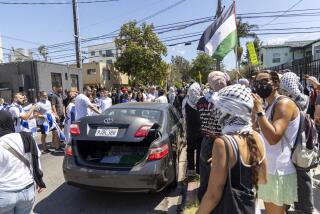Proposal for New Freeway Billboards Remains Up in Air
- Share via
Faced with widespread opposition, the Los Angeles City Council on Tuesday balked at a proposal to allow 140 new billboards along Los Angeles freeways.
Under the proposal, companies that take down at least 2,100 signs on city streets would be allowed to put up the new freeway signs.
The council delayed action for a week after council members Cindy Miscikowski and Mike Feuer proposed instead a ban on new billboards, and stronger action against illegal signs.
Miscikowski said her plan could bring down 4,000 illegal billboards without giving up the current ban on billboards along freeways.
“Why shouldn’t we reduce the billboards that are now illegal without giving anything away?” Miscikowski asked her colleagues.
City officials estimate there are about 9,700 billboards in Los Angeles. Because there is no regular inspection program, officials do not know how many are illegal.
Action was delayed after an hourlong hearing at which nearly a dozen residents and activists from Silver Lake, Hollywood, Glassell Park, West Los Angeles, Valley Village and Northridge testified against the plan, citing visual blight and traffic safety.
Some of the opponents noted that billboard companies have put $694,000 into campaigns for candidates in Tuesday’s city elections.
“A vote of ‘yes’ on this is a vote for big-money contributors,” said Richard MacMinn, a Hollywood neighborhood activist. “A vote ‘no’ is a vote for your conscience and for constituent wishes.”
Walter Prince of the Northridge Chamber of Commerce questioned how the city could agree to a trade-off without knowing for certain how many existing billboards are illegal and without studies on the environmental impact of dozens of new billboards.
“We don’t know what the content is going to be, if school buses are going to be subject to topless bar advertising,” Prince said.
Lori Dinkin, president of the Valley Village Residents’ Assn., joined others in demanding a traffic safety study, citing the potential for additional freeway signs to cause more accidents.
“I think that’s all we need on the freeways, is to distract our motorists,” Dinkin told the council.
The city Department of Transportation routinely denies permits for any billboard on private property that can be clearly seen from a freeway.
It considers such billboards potential traffic hazards, officials said.
Councilman Hal Bernson said any new billboard would have to go through an approval process established by the California Department of Transportation that includes spacing requirements for safety reasons.
“The responsibility for freeway safety belongs with Caltrans and the state,” Bernson said. “It is not a city issue.”
Bernson and Councilman Mark Ridley-Thomas said some sort of trade-off that allows freeway signs appears necessary to significantly reduce the number of billboards already erected in city neighborhoods.
“We need the ability to be able to get some of these other boards down,” Bernson said.
Ridley-Thomas proposed a trade-off formula requiring the removal of 15 existing small, medium and large signs for every new freeway billboard, which could result in 2,100 older billboards being removed.
“We will take billboards down, which in my view is the objective we ought to be seeking,” Ridley-Thomas said, adding that the proposal would “accomplish something of consequence.”
That plan is supported by some members of the billboard industry as long as most signs taken down would be small to medium-sized, said Ken Spiker Jr., a lobbyist for the firms.
The Planning Department has proposed that 10 square feet of old billboards should be removed for every square foot of new freeway billboards, which could result in 7,700 billboards being taken down.
Miscikowski and Feuer submitted a substitute motion that would create a permanent moratorium on new billboards, with a provision for hardship exemptions.
The proposal would require all billboard companies to produce permits for all of their signs.
The measure, written by Miscikowski, would require copies of permits to be displayed on the pole of each billboard for easy access by inspectors, and would ask the Building and Safety Department to report on the staffing and funding needed to mount an inspection and enforcement program.
More to Read
Sign up for Essential California
The most important California stories and recommendations in your inbox every morning.
You may occasionally receive promotional content from the Los Angeles Times.










